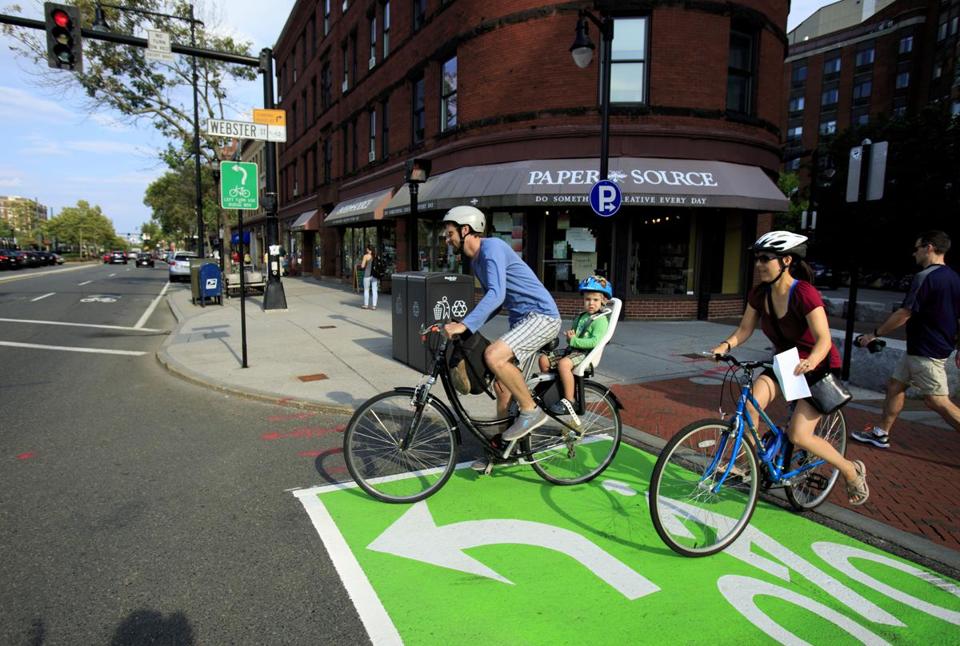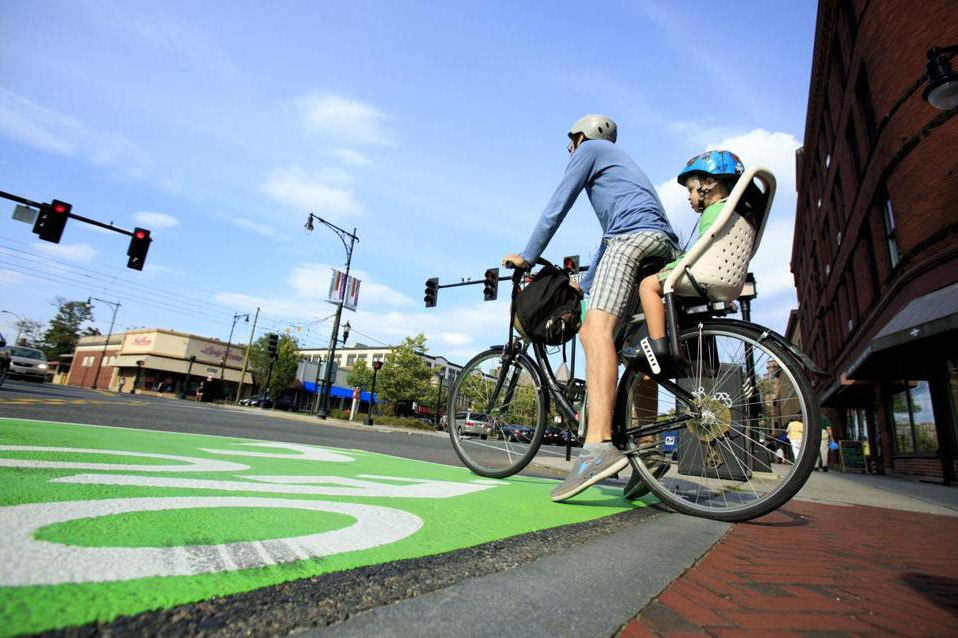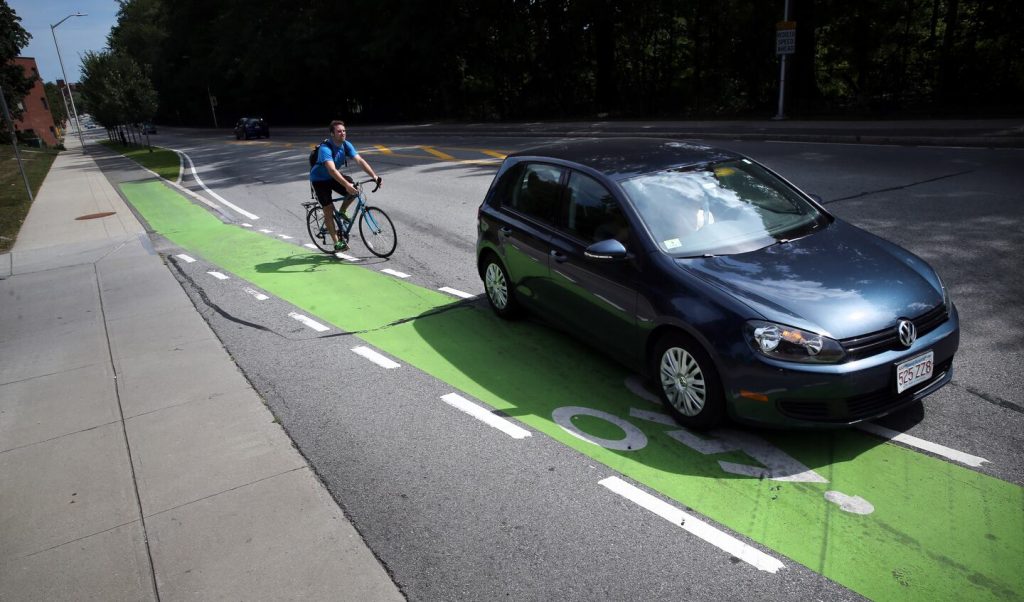My letter to the editor of the Globe today.
To the editor:
Yes, I know this is too long to publish, but I hope that you will find it informative.
A major impediment to safe bicycling and good street design is lack of knowledge. In the feature article “Safer Passages”, on the cover of Globe West, Sunday, September 6, and online at https://www.bostonglobe.com/metro/regionals/west/2015/09/05/thinking-outside-bike-lane/cF6JDiRId8JAPWD7XEa1YI/story.html, The Globe reveals a serious and unfortunate lack of depth in reporting about bicycling, publishing an article rife with technical error, and photos showing bicyclists who clearly do not know basic riding skills, also unquestioningly and enthusiastically making and relaying unsubstantiated claims of safety. In this way, the Globe fails to inform the public about bicycling, and about planning and design for bicycling.
The top photo in the article [not seen in some archives] is captioned “A bike box at a Brookline intersection allows bicyclists to wait ahead of vehicles during a red light.”

The Globe uses the term “bike box” incorrectly. A bike box would be placed before, not after the crosswalk. The arrow and sign in the photo clearly identify not a bike box but a two-stage turn queuing box. It purpose is not to allow bicyclists to wait ahead of vehicles, but to allow bicyclists to turn left from the right side of the street.
A two-stage turn queuing box is usually slower than a conventional left turn from near the center of the street, requiring waiting through an additional traffic signal phase — but is useful when merges across multiple lanes of traffic would be needed or conventional left turns are prohibited. The two-stage turn queuing box has been approved by the National Committee on Uniform Traffic Control Devices, which reports to the Federal Highway Administration, see
https://www.ncutcd.org/doc/Attach%2030%20Bike%20No8%20Two-Stage-Turn%20Queuing%20Box.pdf .
(And I should here indicate my personal involvement with preparation of that document, as a member of the National Committee’s Bicycle Technical Committee. My other credentials are listed here: https://bikexprt.com/witness/bikeres3.htm .)
The Globe has posted another photo from the same photo shoot online:

The location is Beacon Street at Webster Street, in Brookline:
Issues raised by these photos:
* The same cyclist with the toddler in a child carrier appears in the two photos taken at different times and from different angles. These are not candid news photos. This was a posed photo shoot, though that is not acknowledged.
* The man’s rear tire is very soft.
* The man is sitting on the saddle, precariously tiptoeing with both feet. He does not know how to stop and restart on a bicycle, and is at considerable risk of the bicycle’s falling over with the child on board.
* He is carrying a bag over the handlebar where it interferes with pedaling and disturbs steering. There is a risk that an object carried on the handlebar might fall into the front wheel, jamming it and pitching the bicycle forward.
* The woman cyclist in one of the photos, though she has a purse, is illegally carrying papers in her left hand (author Lefferts, carrying notes for her story?), preventing her from using the brake or shift lever on the handlebar. She also has just started from a tiptoeing position: having just raised her left foot off the ground, she should be standing ahead of the saddle, not sitting on it. The rear tire of her bicycle is even softer than the one on the man’s bicycle — nearly flat.
(Where does the Globe find people like this to use as examples of “safer passages”? Think about how this reflects on the Globe’s level of understanding of bicycle issues.)
How to start and stop:
* The cyclists in the larger photo are positioned as if they had entered from Webster Street, though the turn box is intended for entry from Beacon Street. It would have been illegal and discourteous for them to ride across the crosswalk from Webster Street on a red light to wait after the crosswalk, unless to make a legal right turn on red after yielding to pedestrians.
* The photos show a brick crosswalk bordered in granite curbstones. These are expensive to install, do not conform to national standards, are hard to see in wet weather, and as the pavement settles, the brick breaks down and the curbstones produce a jarring bump for bicyclists. The use of brick paving and granite curbstones for crosswalks is endemic in the Boston area and in my opinion rates as a scandal deserving of attention from the Globe Spotlight Team.
A few years ago, much of Kenmore Square was outfitted with such crosswalks, and block pavers. How these paving materials work in practice is described in the blog post here:
https://john-s-allen.com/blog/?p=4456
and illustrated, in the first 30 seconds and again at 1:05 in the video here:
But now about bike boxes, as they have been mentioned. Are they a safety measure?
A bike box, see http://nacto.org/publication/urban-bikeway-design-guide/intersection-treatments/bike-boxes/ incites bicyclists to overtake in motorists’ right rear blindspot, placing them in the “coffin corner” where they can be to be run over by right-turning vehicles. The bike box encourages bicyclists, upon reaching the intersection, to swerve left in front of the first waiting motor vehicle without any way to know when the traffic signal is going to change. Portland, Oregon has reported a doubling of the crash rate at some intersections with bike boxes,
http://www.portlandmercury.com/images/blogimages/2012/10/16/1350403953-bike_box_letter_merc.pdf
including two gruesome fatalities and a severed leg:
http://www.oregonlive.com/portland/index.ssf/2015/05/officials_identify_bicyclist_k.html
Want to see how a bike box in Boston is actually working? Try this 5-minute video.
NACTO, by the way, lacks official status and a vetting process like the NCUTCD. Please read my comments about the NACTO pages on the two-stage turn queuing box here, to understand these issues. https://john-s-allen.com/blog/?p=6051
Now, let’s examine the other purportedly safe example shown in the smaller photo on the Globe West home page.

This is a so-called through bike lane which runs diagonally across another lane. It assigns priority to bicyclists in a lane change, discouraging them from looking back to see whether that is safe. This design was included in 2011 in the first edition of the NACTO Urban Bikeway Design Guide, then rejected in the 2012 edition as unsafe, even by NACTO. See:
http://nacto.org/publication/urban-bikeway-design-guide/intersection-treatments/through-bike-lanes/#design (Click on the “design Guidance” insert to enlarge it and look at its lower right corner for the red X.)
The Boston Globe touted this treatment even after NACTO rejected it.
The one in the photo is on Concord Avenue east of Blanchard Road in Cambridge. The green pavement before it goes diagonal is a bus stop where passengers cross the bike lane, and the looonng curb cut on the left is for the driveway to Sancta Maria Hospital: the tire marks in the foreground are from vehicles cutting across the bike lane to enter the driveway, if it weren’t bad enough already. Safer would be to merge into the line of traffic as traffic permits, and never to pass a stopped bus on the right — but hose options have vbeen eliminated by placing the bikeway behind a curb.
The problems were already obvious with the first Cambridge installation years ago, see
https://bikexprt.com/massfacil/cambridge/bluelane.htm
How this design works in practice is illustrated in the video here, shot at the Concord Avenue location.
All in all, again, the Globe’s coverage of bicycling needs a major revamp. Thanks for reading this.

Leave a Reply
You must be logged in to post a comment.